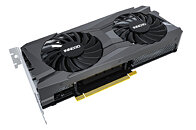- Joined
- Oct 9, 2007
- Messages
- 47,231 (7.55/day)
- Location
- Hyderabad, India
| System Name | RBMK-1000 |
|---|---|
| Processor | AMD Ryzen 7 5700G |
| Motherboard | ASUS ROG Strix B450-E Gaming |
| Cooling | DeepCool Gammax L240 V2 |
| Memory | 2x 8GB G.Skill Sniper X |
| Video Card(s) | Palit GeForce RTX 2080 SUPER GameRock |
| Storage | Western Digital Black NVMe 512GB |
| Display(s) | BenQ 1440p 60 Hz 27-inch |
| Case | Corsair Carbide 100R |
| Audio Device(s) | ASUS SupremeFX S1220A |
| Power Supply | Cooler Master MWE Gold 650W |
| Mouse | ASUS ROG Strix Impact |
| Keyboard | Gamdias Hermes E2 |
| Software | Windows 11 Pro |
It looks like Spring-Summer will see NVIDIA's GeForce RTX 40-series get a rapid ramp up to high-volume market segments. In April, the company is planning to release the GeForce RTX 4070, which should hold the performance-segment end of things, albeit at an eye-watering $750 rumored price. May 2023 could see NVIDIA come out with two product launches before the 2023 Computex; the GeForce RTX 4060 Ti, and the RTX 4060.
Both the RTX 4060 Ti and RTX 4060 are expected to be based on the "AD106" silicon, which is expected to have around 36 streaming multiprocessors (4,608 CUDA cores, 144 Tensor cores, 36 RT cores, 144 TMUs, 48 ROPs); and a 128-bit wide memory interface. NVIDIA is expected to use 18 Gbps-rated conventional GDDR6 memory chips with these SKUs, which should lower costs (for the company) in comparison to the more exotic 19 Gbps GDDR6X.

The faster GeForce RTX 4060 Ti is expected to feature 32 out of 36 SM, which should mean 4,352 CUDA cores, 128 Tensor cores, 32 RT cores, 128 TMUs, and 48 ROPs. The more affordable RTX 4060 (non-Ti), is expected to be cut down further, or perhaps even be a maxed out version of the "AD107" silicon, featuring 3,072 CUDA cores. Both SKUs are expected to feature 8 GB as the standard memory amount, using 18 Gbps GDDR6 memory, which across the 128-bit interface should provide 288 GB/s of memory bandwidth. With the typical graphics power (TGP) of the RTX 4060-series expected to be well under the 200 W-mark, graphics cards could more extensively feature common 8-pin PCIe power connectors, instead of the 16-pin 12VHPWR.
View at TechPowerUp Main Site | Source
Both the RTX 4060 Ti and RTX 4060 are expected to be based on the "AD106" silicon, which is expected to have around 36 streaming multiprocessors (4,608 CUDA cores, 144 Tensor cores, 36 RT cores, 144 TMUs, 48 ROPs); and a 128-bit wide memory interface. NVIDIA is expected to use 18 Gbps-rated conventional GDDR6 memory chips with these SKUs, which should lower costs (for the company) in comparison to the more exotic 19 Gbps GDDR6X.

The faster GeForce RTX 4060 Ti is expected to feature 32 out of 36 SM, which should mean 4,352 CUDA cores, 128 Tensor cores, 32 RT cores, 128 TMUs, and 48 ROPs. The more affordable RTX 4060 (non-Ti), is expected to be cut down further, or perhaps even be a maxed out version of the "AD107" silicon, featuring 3,072 CUDA cores. Both SKUs are expected to feature 8 GB as the standard memory amount, using 18 Gbps GDDR6 memory, which across the 128-bit interface should provide 288 GB/s of memory bandwidth. With the typical graphics power (TGP) of the RTX 4060-series expected to be well under the 200 W-mark, graphics cards could more extensively feature common 8-pin PCIe power connectors, instead of the 16-pin 12VHPWR.
View at TechPowerUp Main Site | Source






